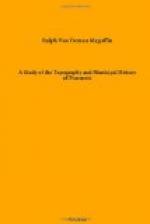[Footnote 89: Cecconi, Storia di Palestrina, p. 338, speaks of this aqueduct as “quel mirabile antico cuniculo.”]
[Footnote 90: The springs Acqua Maggiore, Acqua della Nocchia, Acqua del Sambuco, Acqua Ritrovata, Acqua della Formetta (Petrini, Memorie Prenestine, p. 286).]
[Footnote 91: Fernique, Etude sur Preneste, p. 96 ff., p. 122 ff.; Nibby, Analisi, II, p. 501 ff.; Marucchi, Guida Arch., p. 45.]
[Footnote 92: Nibby, Analisi, II, p. 503, the sanest of all the writers on Praeneste, even made some ruins which he found under the Fiumara house on the east side of town, into the remains of a reservoir to correspond to the one in the Barberini gardens. The structures according to material differ in date about two hundred years.]
[Footnote 93: C.I.L., XIV, 2911, was found near this reservoir, and Nibby from this, and a likeness to the construction of the Castra Praetoria at Rome, dates it so (Analisi, p. 503).]
[Footnote 94: This is the opinion of Dr. Esther B. Van Deman of the American School in Rome.]
[Footnote 95: See above, page 29.]
[Footnote 96: There is still another small reservoir on the next terrace higher, the so-called Borgo terrace, but I was not able to examine it satisfactorily enough to come to any conclusion. Palestrina is a labyrinth of underground passages. I have explored dozens of them, but the most of them are pockets, and were store rooms or hiding places belonging to the houses under which they were.]
[Footnote 97: This is shown by the network of drains all through the plain below the city. Strabo V, 3, 11 (C. 239); Vell. Paterc. II, 27, 4; Valer. Max. VI, 8, 2; Cecconi, Storia di Palestrina, p. 77; Fernique, Etude sur Preneste, p. 123.]
[Footnote 98: Cicero, de Div., II, 41, 85.]
[Footnote 99: There are many references to the temple. Suetonius, Dom., 15, Tib., 63; Aelius Lampridius, Life of Alex. Severus, XVIII, 4, 6 (Peter); Strabo V, 3, 11 (238, 10); Cicero, de Div., II, 41, 86-87; Plutarch, de fort. Rom. (Moralia, p. 396, 37); C.I.L., I, p. 267; Preller, Roem. Myth. II, 192, 3 (pp. 561-563); Cecconi, Storia di Palestrina, p. 275, n. 29, p. 278, n. 37.]
[Footnote 100: “La citta attuale e intieramente fondata sulle rovine del magnifico tempio della Fortuna,” Nibby, Analisi, II, p. 494. “E niuno ignora che il colossale edificio era addossato al declivio del monte prenestino e occupava quasi tutta l’area ove oggi si estende la moderna citta,” Marucchi, Bull. Com., 32 (1904), p. 233.]
[Footnote 101: This upper temple is the one mentioned in a manifesto of 1299 A.D. made by the Colonna against the Caetani (Cecconi, Storia di Palestrina, p. 275, n. 29). It is an order of Pope Boniface VIII, ex Codic. Archiv. Castri S. Angeli signat, n. 47, pag. 49: Item, dicunt civitatem Prenestinam cum palatiis nobilissimis et cum templo magno et sollempni ... et cum muris antiquis opere sarracenico factis de lapidibus quadris et magnis totaliter suppositam fuisse exterminio et ruine per ipsum Dominum Bonifacium, etc. Petrini, Memorie Prenestine, p. 419 ff.




